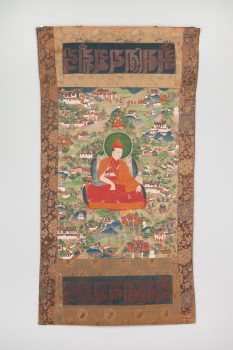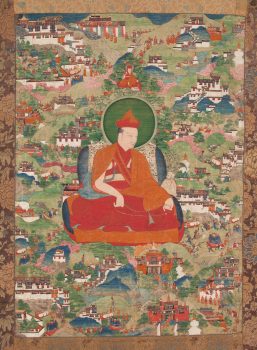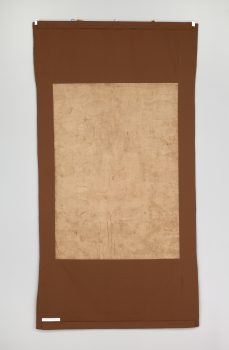Tibet
17th century



Tibet
17th century



The painting illustrates the biography of a teacher from the Khon family lineage of the Sakya School of Tibetan Buddhism. It shows him as a large central figure and in smaller surrounding scenes. These narrative vignettes, set in recognizable architectural depictions within the landscape, can be identified by faded inscriptions. They tell the story of the teacher’s various activities while traveling to these places. You can see him teaching, performing rituals, and engaging in ritual dances. One of the places identified by inscription and shown to the immediate right of the central figure is Samdrubtse, a fifteenth-century castle where he warded off negative forces. Samdrubtse is thought to be the model for the Potala Palace in Lhasa.
A virtuous feeling and deep respect toward an authentic teaching, teacher, or path. Buddhists believe that expansive study, analysis, and meditation are essential steps for cultivating a healthy and enduring devotion.
A vehicle for the preservation and transmission of knowledge. The Buddha’s teachings were originally passed down through oral transmission and storytelling, and stories of the Buddha’s past lives are considered an important source of inspiration and guidance.
The transmission of teachings from one generation to the next, from teacher to student, traced all the way back to the Buddha without interruption. A complete lineage is essential in Tantric Buddhist practices as it makes the blessings of the teaching more powerful.
Himalayan art includes portraits of legendary and historical humans, including accomplished religious teachers (lamas), the Buddha’s original disciples (arhats), and spiritually accomplished tantric masters (mahasiddhas).
Today, Tibetans primarily inhabit the Tibetan Plateau, situated between the Himalayan mountain range and the Indian subcontinent to the west, Chinese cultural regions to the east, and Mongolian cultural regions to the northeast. During the 7th to 9th century, Tibetan rulers expanded their empire across Central Asia, and established Buddhism as the state religion.
Get the latest news and stories from the Rubin, plus occasional information on how to support our work.